Websites at present can be considered as lead revenue generators which bring much more traffic than physical businesses in today’s world. It means that the consumers are captivated by the content and the products displayed over the websites. Therefore, the growing company revenue through the websites is one of the major factors leading businesses toward recognizing the need of website localization. This article will take you through all the essential details that you need to know about web localization.
Familiarizing with Web Localization
What is meant by web localization? Web localization can be termed as the process of adapting a website in order to suit a particular audience that speaks different languages, come from different cultural morals and values. It can actually be a very complex procedure, since there are various parts to it. Like, there is a technical side that ranges from confirming that the code which the website uses can well handle alphabets with various characters and symbols ensuring that the website’s payment processing system is able to handle transactions in the necessary region and currency. Next, comes the language side. So, you will have to understand that the term web localization is not only about converting copy from one language to the other. There is a need to ensure that the translation procedure takes consideration of local cultural sensitivities, doesn’t include famous culture references which might get lost on the target audience, holds the right tone and doesn’t use phrases or idioms which won’t be translated well.
A look at the benefits
In this section you will find some of the major benefits which you need to consider before selecting website localization.
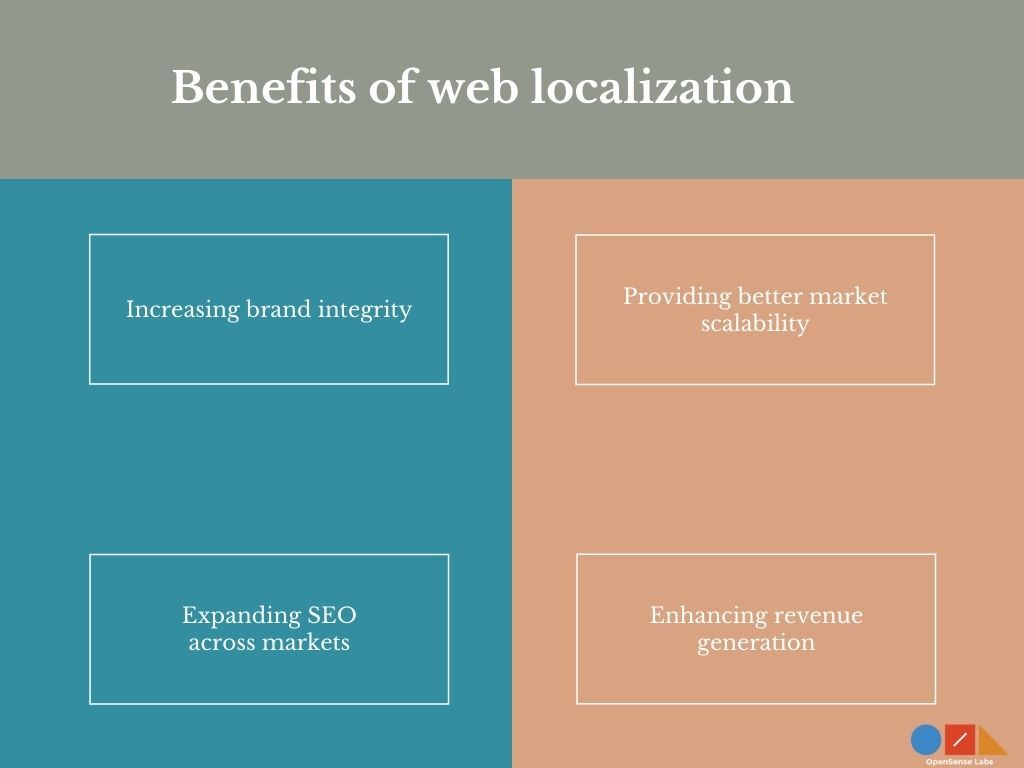
Increasing brand integrity
Mostly consumers will come to know about your brand via your website, therefore convenient website localization helps in keeping your brand consistent over markets. You are required to contact somebody who is native to your market, and he/she can possibly review your content before it goes live. By doing so, you can avoid grammatical mistakes, or translation context errors. Since, definite words and phrases tend to vary across languages and cultures, and in situations like that adjusting your terminology to cultural values and norms can be helpful in keeping your brand consistent and enhancing consumer loyalty in various markets.
Providing better market scalability
Good strategies enable you to scale into multi-language localization. It helps in streamlining the procedure by enabling you to choose an initial target market and also prioritize the content most significant to those consumers. Some of the businesses can be seen testing machine translation during this procedure to assess the amount of traffic their website gets and also identify the type of content that brings the maximum views, and later in accordance with that research, design their content strategy. So, scaling content localization proves to be an efficient and economical way in testing your product on new markets over numerous languages.
Expanding Search Engine Optimization (SEO) Across Markets
SEO helps in increasing the visitors traffic from markets by examining search engine algorithms and raising website ranking over the search engine results pages. Strong localization strategies safeguard SEO terms by mapping content’s selected keywords, allowing your website ranking to increase over various markets and enabling you to expand traffic while looking after your site’s integrity. Read the complete guide on SEO here.
Enhancing revenue generation
With every new market arises the possibility of a new revenue stream. A well-planned SEO strategy helps in increasing the number of visitors to your sites and, also good quality localization makes it possible to increase your product’s perceived value in every market, allowing consumers to select your product over the competitors. Additionally, by localizing your website, you can easily operate in a new market avoiding the overhead costs of staffing, physical locations such as storefronts and warehouses, and legal fees among the others. Such a streamlining enables faster product expansion over the market with minimum effort to maximize your organization’s revenue.
Is there a need to localize your website?
According to Harvard Business Review, 72.4% of web users confirm that they prefer purchasing a product if its information is available in their own language. And 72.1% reveal that they are more comfortable to look for any online information over the websites in their own native language. Therefore, localizing your website can be a good option if you want to increase the number of visitors from the market. Do not forget that even though language plays a significant role in increasing online shoppers, localization is a lot more than just translating your site’s text. It includes:
- Adapting design to local preferences and cultural expectations
- Raising SEO rankings to the top of search-engine results
- Ensuring an improved website loading performance
- Adopting a secure payment gateway which accepts various currencies.
But here comes a question, what if you are not into selling products and therefore do not require things such as payment gateways and displaying exact prices in multiple currencies? Let’s say, if you run a blog. Would you still go for localizing your website? Well, if you do not have a sufficient number of visitors from outside your region, or if there is no necessity of reaching out to an international audience, you can definitely avoid localization. But again, you can probably make a smart move of localizing your website, if you happen to see a huge traffic from any particular region. For instance, if your blog has high traffic in Spanish and French markets, then you can certainly take a step of localizing your blog for those particular languages.
Is there any right time to localize your website?
After understanding the importance of website localization, it is very essential to comprehend the appropriate time of localizing your website. There are various factors depending upon which you can localize your website such as international expansion or long-term goals and endeavors. Some of the examples that lead to localizing websites can be like the launch of a brand-new product which is to be well received specially overseas. Next, if your competitor happens to launch a localized website in various languages, then you might feel the need of doing the same in order to keep up with the competition. Then significant international expansion can be one of the essential reasons to opt for localization. What if, your company develops a franchise model which has the capability of going beyond the national borders, won’t you prefer localization? Also, if there is any change in the legal or compliance requirements, like the introduction of the General Data Protection Regulation (GDPR), then it might lead to localization. And, finally, you can move towards localization if there is any shift in your supply, manufacturing or any other logistical arrangements.
Things to know before going through the process
This section includes various factors which have to be considered before starting the localization process.
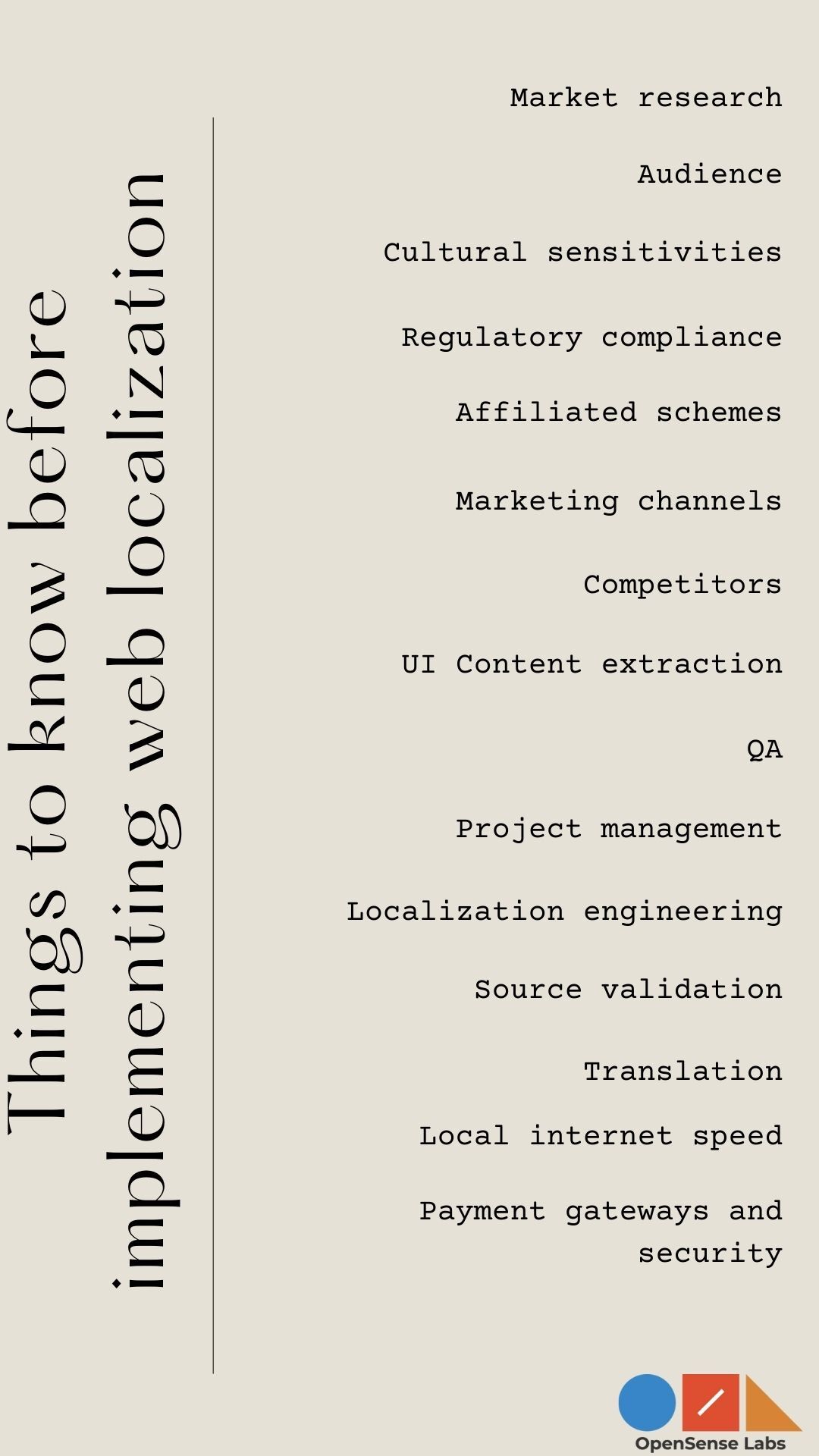
A proper market research
Before you launch any product or services, it is important to have market research. By doing so you get a better understanding about your target audience, whether your audience is domestic or international. Websites are required to have a relevant purpose for justifying the localization expenses. Therefore, market research enables you to define, shape and evaluate that particular purpose.
Knowing your ideal audience
Understanding your target audience is a must. Sometimes people living in the same territory might speak different languages. So, in such a bilingual society, you will have to prioritize both the languages and offer respect to the users. Then, in a multilingual society, you need to translate to the lingua franca and/or the language used by the majority of the people. By doing so you can value every user and at the same time build a positive image of your brand. And, at times, website translation is needed by law. For example, in Quebec French is the provincial language, and therefore, you will have to include a French version of your website.
Understanding cultural sensitivities and associations
You will have to pay attention that some of the gestures which are positive and completely acceptable in some cultures might be offensive in others. Let’s say, an image or a gesture which is recognized in one country might be unknown to audiences of a different country. So, along with gestures, you will have to research your brand colors’ associations in the markets you are planning to enter into. The color psychology tool can help you in fixing a color palette for your brand. But keep in mind that you should be utilizing it in conjunction with an understanding of colors’ cultural associations.
Let’s consider you own a coding tutorial website. Your current audience comprises IT professionals, and especially college graduates. You see a great future in India. But localization is doubtful in this case, as most of the engineers hold a grasp of English. So, rather than going for a web translation project, you can utilize your money to enhance or build a new product or service for your Indian audience.
Learn more:
- How to champion diversity and inclusion in tech
- Diversity, inclusion and equity in open source
- How diverse design teams encourages innovation
- Diversity and inclusion in Drupal
Understanding the regulatory compliance
Before committing to localize your website, you need to understand the local operating environment. Let me give you an example of the local regulatory requirements, i.e., EU General Data Protection Regulation or GDPR. It is a legislation which has created plenty of work for businesses with operations in the European Union. So, if anybody wants to enter the EU marketplace, then they will have to consider this legislation for sure. Basically, every country has its own needs and requirements, so any business who looks forward to expanding internationally has to understand these in detail from an operational point of view in regard to how it will be impacting the localization efforts.
Knowledge upon the affiliated schemes
Every country has its own options in regards to affiliated schemes, so it’s imperative to have a proper idea about what these are and how they actually work before entering a new region with your localized website.
A proper grip on marketing channels
It is essentially important to know in which way you will promote your brand and market your products in your preferred location. As advertising, marketing and PR is an extensive subject area, you need to be very clear on your plans before beginning with your website localization.
Familiar with local competition
You should have a clarity upon whom your localized website will be competing with. How will your company prove its specialty or uniqueness in comparison to the local competitors? So, you need to be very careful with all such important knowledge which can help you to successfully localize your website in a foreign land.
Familiar with UI content extraction
Are you aware of the fact that global website localization begins with content extraction? It means you will require a complete detailed content inventory and process mapping, which includes creating a glossary or lexicon of text strings and data points to be translated. The automated procedures with human oversight tend to deliver the most effective approach and can well accommodate everything, starting from language direction to functionality.
A proper hold on linguistic and functionality quality check
Quality assurance (QA) can be considered as a primary component of website localization, especially given the use of automated tools during the procedure. Along with a good website language quality, the human oversight also provides a good standard functionality and better user experience.
Project management skills
Since large volumes of content are involved in any website localization, the jobs related to this profile can be really complex. Therefore, there will be a need for excellent project management at your company. A potential project manager will be able to supervise the website localization ensuring that each part of the procedure stays well on track. Be it budgetary control, the translation of video content, granular task assignment or compliance with the overall timeline, the project manager will handle it all with his exceptional work skills.
Learn more:
- The curious case of human psychology in project management
- How important is technical know-how for project managers
- Agile development methodology for project management
Knowing the localization engineering process
This specific technical part of the website localization includes everything, starting from correctly integrating files into the code stack to confirming that all placeholders are located and formatted correctly before the language and data inputs go in. The complexity of your website in relation to its functionality in the original language will influence exactly what you require from the localization engineering procedure.
Knowing the source validation process
Source validation can be termed as the procedure of confirming that the localized website behaves as per expectation. It’s the other technical part of the process which combines both automation and skilled human oversight.
Prioritizing the translation process
Translating your website’s text can be considered as a big component of localization. It can be seen that some of the browsers automatically translate text on pages, but if you allow your browser to translate pages before, the translations might come out to be very dull or uninspired and even wrong at times. This is when you should hire a human translator for your site. Along with selecting the right words and structure the sentences perfectly, the human translator will recognize the cultural and linguistic nuances and translate your text into readable, engaging copy which can connect well with the target audience.
By having natural and quality copy on your site, you will be able to boost your SEO, allowing your website to reach the maximum number of viewers in your target market. With a professional translator you can work upon relevant keywords into your text as well.
Understanding the local internet speed
5G is still not available everywhere. Around the globe, there are billions of internet users who are still on 3G and 4G networks. Consequently, your website will load quite slowly for them, and images, animations and videos will straight away slow things down for them as well, increasing your bounce rate with users with much slower connections. So, while developing localized versions of your website, you need to keep every country’s average internet speed in mind. It will be beneficial to scale down your website and simplify your interface in countries with such slower connections.
Prioritizing payment gateways and security
While operating an ecommerce website, you must look after a secure international payment gateway. Without such a payment gateway, you won’t be able to securely accept payments from credit and debit cards from buyers outside your nation. You will find many international payment gateways such as PayPal and Stripe.
The common website localization mistakes to be avoided
This section will show you some of the major mistakes that you need to avoid while localizing your own website.

Opting for the wrong translation process
Translation plays an important role in the localization process. Therefore, it is essential to select a translation solution which is able to find the perfect balance between cost, accuracy, speed and ease of maintenance. Well, there are two ways of translating your website, such as human translation and automatic/machine translation.
The human translation involves hiring professional translators who translate all your websites on a page-by-page basis. You can expect accurate and high-quality translations from the professional translators undoubtedly. But before opting for this option, you need to look at some of the considerations. The very first thing you need to do is to think about the technical aspects behind a multilingual website. The important thing to be understood here is, the professional translators will not be capable of assisting you at the time of integrating these translations onto your website. The second thing that you need is the cost factor. As professional translations are quite expensive, if you require to translate around thousands of pages, then this option no longer proves to be convenient for you.
In order to meet your multilingual needs, automatic machine translation proves to be a good choice. While considering this choice, the question of translation quality is being raised, although automatic machine translation happens to be enhancing in accuracy year after year. Additionally, this process is speedy and cost-effective as well. But website translation can be very challenging at the same time.
Choosing inappropriate translation technology
Be particular about picking the right translation technology. Since, various translation solutions are seen dealing with your content in numerous ways, some of them are not even considered as the best practices for multi-language websites. Your multilingual website architecture needs to avoid the utilization of duplicate pages or websites. The particular reason for this is since the duplicate pages and websites are completely penalized by search engines (ex. Google) while it comes to highly rank on search engine result pages. Preferably, your localized content in the specific language needs to live under the same URL as your original language within language-specific subdomains or subdirectories. So, under this architecture, duplicate content penalties from Google are also being avoided.
Neglecting design of your site
One important mistake to avoid while localization is to not consider thoroughly the design of your site. While translating your website, it’s significant to clearly understand the role of your website’s design in this. Regardless of the fact that the CMS you’re using, one of the very first things you need to consider is utilizing a well-developed theme for your website. You need to ensure that your selected theme is broadly compatible with the other applications and plugins which can improve your website’s functionality, that it uses RTL (right-to-left) formatting, and also that it's well-structured and designed at the same time.
While incorporating your translated content into your website’s design, you will have to be aware of the fact that how it will look on your webfront. This is since languages not just differ in sound and syntax but also in regards to the space words occupy in a given sentence. Consequently, it’s imperative to consider this while designing your website by leaving enough space in your design to cater to variations and discrepancies related with translating from one language to the other. If you fail to anticipate this then it might result in things like broken strings and overlapping text. And, lastly, you need to avoid custom fonts on your website. These customized fonts cannot be easily translated and can further cause unessential difficulty or trouble while going multilingual.
Learn more:
- Complete guide on web design
- Guide to design for safety
- Ethical design
- User centered design approach
- Building user trust in UX design
- Designing for sustaining attention
- Cross cultural design
- A designer’s approach to decision making
- Significance of writing for designers
Not contemplating cultural context
It is essentially important to localize in regards to specific geographic regions. Let’s consider that two of the countries have similar first languages, still they can have a lot of distinct differences, and eventually you will need to tailor your commercial approach to localized language. In order to do this successfully, a consideration has to be made in regards to the cultural context of every market you’re targeting. For instance, English is the native language of both the U.S.A., and the U.K, yet both the countries are very dissimilar.
Not prioritizing international SEO
Once your website is ready for the customers around the world, you will definitely ensure that they find it easily while browsing online. So, this can be made possible with the help of a good multilingual SEO strategy. Multilingual or international SEO is simply doing everything that has already been done to the domestic level SEO, however for each language version of your website. For successful multilingual SEO, it will require a complete translation of your website content, translation of any metadata on your website, adding hreflang tags, and also having language-specific subdomains or directories.
The finest website localization tools
It's time to check some of the website localization tools which can make the localization procedure very accurate and perfect. Well, the list is really long, so I have tried covering the most popular ones. Let’s start with Computer Assisted Translation (CAT). It is one of the most broadly used website translation tools which helps in processing translation files and enhancing efficiency. Next, comes Translation Management Systems, which is one of the efficient website translation software that enables the users to automate much of the translation procedure. Centralized Language Assets comes next. After the content of the website is translated and the site is localized, the centralized language assets can be used to save time. The Term Base tool holds a specific purpose in the website language translation. It can be termed as a glossary created for branding and language purposes.
Then, the Quality Assurance tools are quite similar to the term base, and work for verifying translations. During the website translation process, this Bug Tracking Platform is for the testers to report bugs and content errors. Next, the Machine Translation tool enables speedy translation of website content, with minimum chance of mistake. File Sharing tools help users in sharing the file with the team on a real time basis. Desktop Publishing tools are used in collaboration with clients, as localization engineers are able to edit the content.
The Lokalise tool is the fastest-growing translation management system with clear and clean UI/UX and sufficient pricing. Transifex enables companies to smoothly translate digital content like websites, mobile applications, video, games and many more. Phrase allows teams of all sizes to scale their translation procedures via smart automation. Crowdin, a cloud-based localization management software, reliably creates and manages all multilingual content in one place. XTM Cloud can be termed as an enterprise cloud-based translation management system with an integrated computer-aided translation tool. EasyTranslate can be considered as a complete Translation Management Software that acts as a powerful booster for your translation and content localization procedures.
POEditor is an online localization platform and translation management system which is well designed for teams in order to smoothly collaborate with the required individuals. Localazy is a localization automation platform which is well built for all the digital product makers. WebTranslateIt.com can be regarded as a SaaS localization tool which combines translation management and software translation in an online platform. Applanga is a well-known modern, cloud-based translation management system which is a great option for your software localization requirements and particularly, for native mobile applications and games. Lastly, I am ending with Stringify, a free cloud-based localization and translation platform that focuses on providing ease of use and powerful developer tools.
How to get your web localization project right?
After understanding the above essentials of the localization process, you now need to know how to carry this entire process correctly. So, the question here arises is how do you localize a website? Let’s find out.
Localizing without rebranding
You need to keep in mind that localization is just an adaptation, not a comprehensive rebranding. One of the solutions to efficiently localize your site is to keep its complete look and feel the same, yet build a much more familiar, and engaging environment for the international visitors. It means making very small, visual changes which align with the local visitors’ experiences and various expectations. It might also mean to exchange colors in specific places or in fact entirely changing some definite images. For instance, you may change your graphics and stock photos in order to feature people who your users can recognize with.
Creating your budget in advance
You need to decide an accurate budget for completely localizing your website before you reach out to developers, translators and other creatives. The localizing cost mainly depends on how extensive your localization will be, and are you directly translating your current website to a new language, or are you looking to entirely revamping some important portions of it. Some of the components of localization which you’ll require to include in your budget can be language translation, website development and compliance and linguistic testing. Also, you have the option of hiring a website localization company which will be able to handle the complete process of localizing your website. By doing so, instead of contracting every component of the job individually, you will be able to confirm that each of your website’s “moving parts” will be able to work together.
Deciding your localized domain structure
This particular tip is a bit more technical in comparison to the other localization tips. If you have a few different versions of a website, then there will be few different ways in which you can host them both on your server, and every method has unique advantages and drawbacks. You will be able to build a subdomain for every localized version. In your URL, a subdomain will look like this:
They can be considered as separate websites, therefore, having a subdomain can hamper your SEO. But with a subdirectory, you won’t be having this issue. Additionally, there is an option of a country code top-level domain, which is also known as a ccTLD. It proves to be the best option for SEO. Some of the country code top-level domains are .uk, .ca, .de and other URL endings that aren’t .com, .org or .net. Below is a quick look at the structure’s benefits:
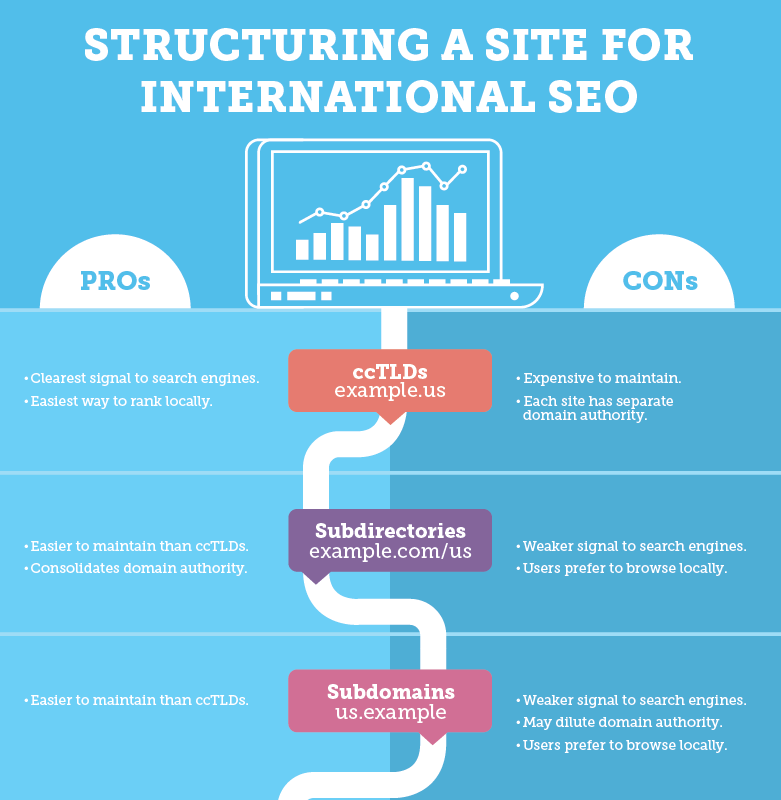
Optimizing for mobile
It is very essential that your website is mobile-responsive. It is one of the major tenets of effective web design. However, when it comes to localizing your site, there’s one more common reason to prioritize mobile-responsiveness, i.e. In some of the countries, people exclusively access the internet via smart phones. Read this mobile first design guide to know more.
Paying attention to the small things
Small things do matter. They can simply be overlooked, like the dollar sign ($) goes before the price in the USA, and the € sign goes after a price in Germany, which your visitors might notice when they are out of order. While localizing your website, along with focusing upon the big picture stuff such as imagery and loading time, you need to ensure that you adapt all the details such as displaying dates in the local format and making measurements available in metric and imperial.
Prioritizing international audiences
By localizing your website, you need to value your international audiences, and show them that your brand is a good fit for them. Even though they can access and visit your site in its original version, there is a high possibility that they would visit and actively interact with your brand if it speaks their language both verbally and visually. Since, localizing a website is an integral part of expanding successfully into the international markets. Therefore, you need to ensure that you work well with the designers and developers who can help you through the entire localizing process.
The brands that have witnessed successful localized experiences
This section brings you some good examples of how brands have successfully localized their experience of resonating with a whole new audience. So, without any further delay, let’s look into the website localization examples.
Netflix

Netflix aims at providing its users with the content they require, and this is carried throughout their platform, starting from movie recommendations on the homepage down to translated subtitles. It has actually become quite popular for its localization efforts on both the translation and developer end. Netflix has developed both the technology and processes they require to not just translate their own applications and interfaces, but even subtitles and voice dubbing of content. Interestingly, it has made great efforts in regards to content creation as it produces its own original movies and series. Therefore, rather than depending on the universal appeal of American creations, Netflix focuses on localizing its content.
AIRBNB
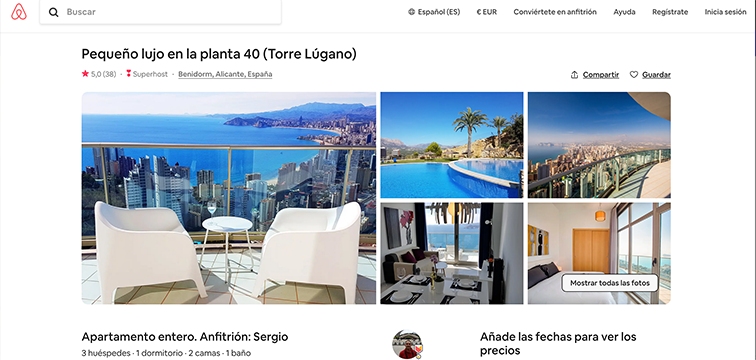
AirBnB is found in over 220 countries around the globe and it happens to disrupt the huge hospitality industry by offering a special personal touch to each interaction. It’s website and application are available in 62 different languages. In order to feel more authentic, AirBnB has in fact made an effort to translate the user-generated content on their website which includes user reviews and listing information. After booking your trip or arriving at your destination, you will be provided localized guides for various regions, pointing out the interesting stuff to do and places to visit, just like a personal tour guide. Also, AirBnB prefers to leverage localization in order to provide an extra level of authenticity and personalization to its experience.
The World Wide Fund for Nature (WWF)
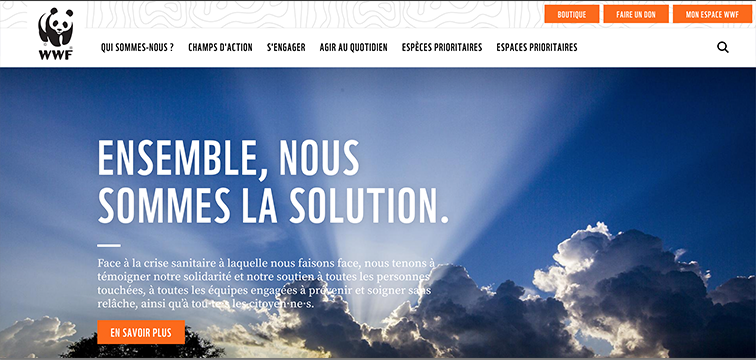
Since 1960, the World-Wide Fund for Nature (WWF) has been actively working in the field of conservation to provide protection to endangered species and habitats. They are offering a good example of how we can empower activism via information and knowledge, and also how localization can provide benefit to these awareness campaigns. To keep the users engaged around the globe, the WWF tends to put a good amount of effort upon not just translating their content, but also delivering the right content to the right users. The WWF offers a much more captivating experience with the content which always feels new and convenient by pointing out the information the readers like the most.
Coca-Cola
Coca-Cola is one of the best examples of a renowned F&B brand with great localization strategies. It has websites available in 118 countries and provides 45 different languages in total. Let’s look at two of its homepages for the U.S. and Japan.

The website that is targeting the U.S. market has its web layout clean and straightforward with very minimum text. You can see six horizontal full-width blocks, each of these ad banners screams “America” without a hint of its flag or country name.
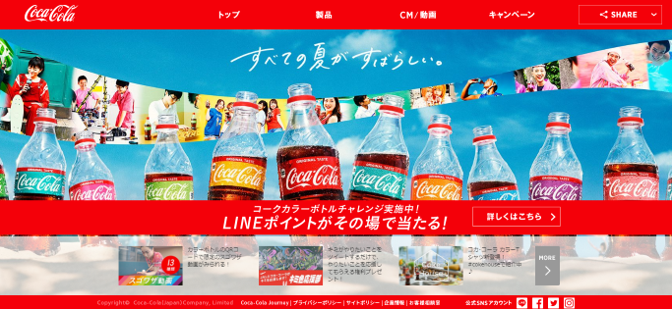
On the contrary, web designs change dramatically for its Japanese website. You will find unique Japanese styles such as densely-packed texts, several small images, and an overstuffed look.
Nike
After visiting the Nike Homepage, the first thing that you will observe is a minimalistic “language tunnel.” The users can choose a preferred region after which a list of countries will pop up. Some of the countries also have multiple languages as an added option. For instance, if you happen to click on “Belgium,” you get the option to choose between Nederlands, Français, English, and Deutsch.
Therefore, all the above brands can be taken as a motivation to opt for website localization amidst all the challenges and difficulties which come along with the localization process.
Conclusion
I hope by now you have understood the necessity of localizing your website and look forward to making it a part of your priority list. But, yes, I do agree that looking at the wide range of things to consider, it can be quite a complicated process to seek growth internationally. However, with the growing support from the different localization companies, it is possible to make it happen. So, why not give it a try?
Subscribe
Related Blogs
Trek n Tech Annual Retreat 2025: A 7-Day Workcation of OSL
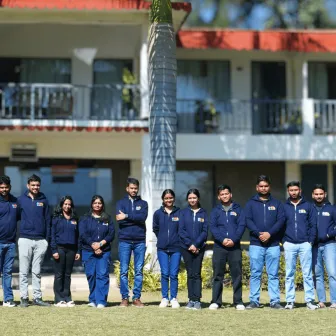
OSL family came together for the Trek n Tech Annual Retreat 2025, a 7-day workcation set amidst the serene beauty of…
Exploring Drupal's Single Directory Components: A Game-Changer for Developers

Web development thrives on efficiency and organisation, and Drupal, our favourite CMS, is here to amp that up with its…
7 Quick Steps to Create API Documentation Using Postman

If you work with API , you are likely already familiar with Postman, the beloved REST Client trusted by countless…




